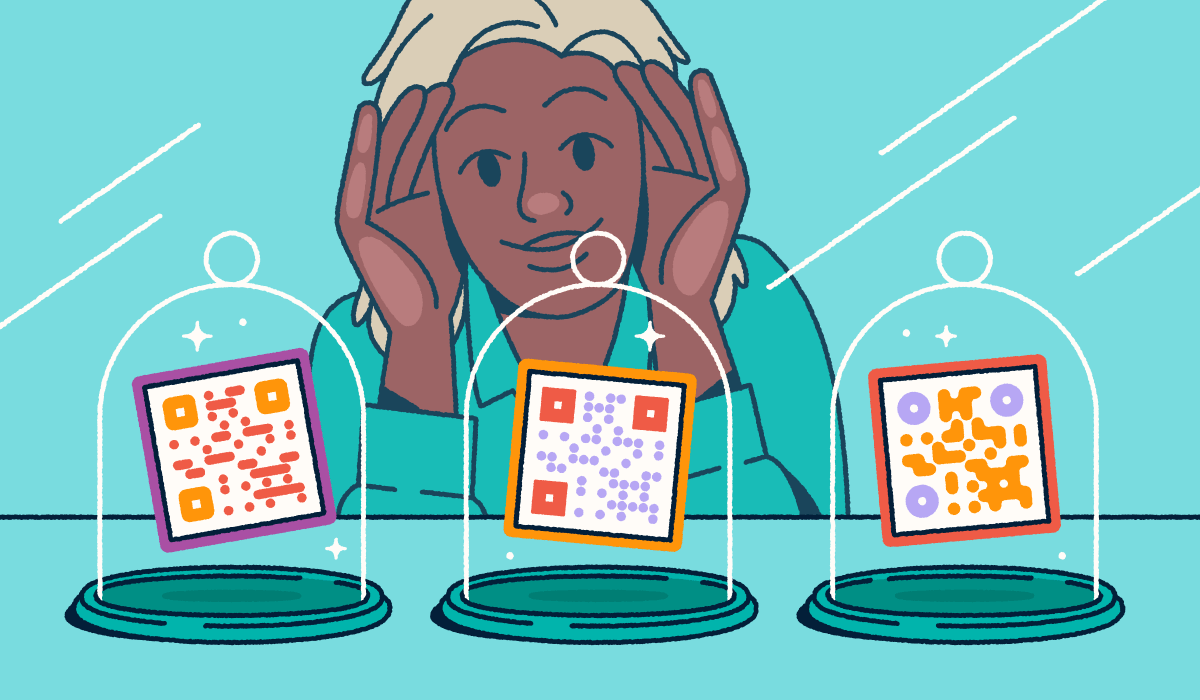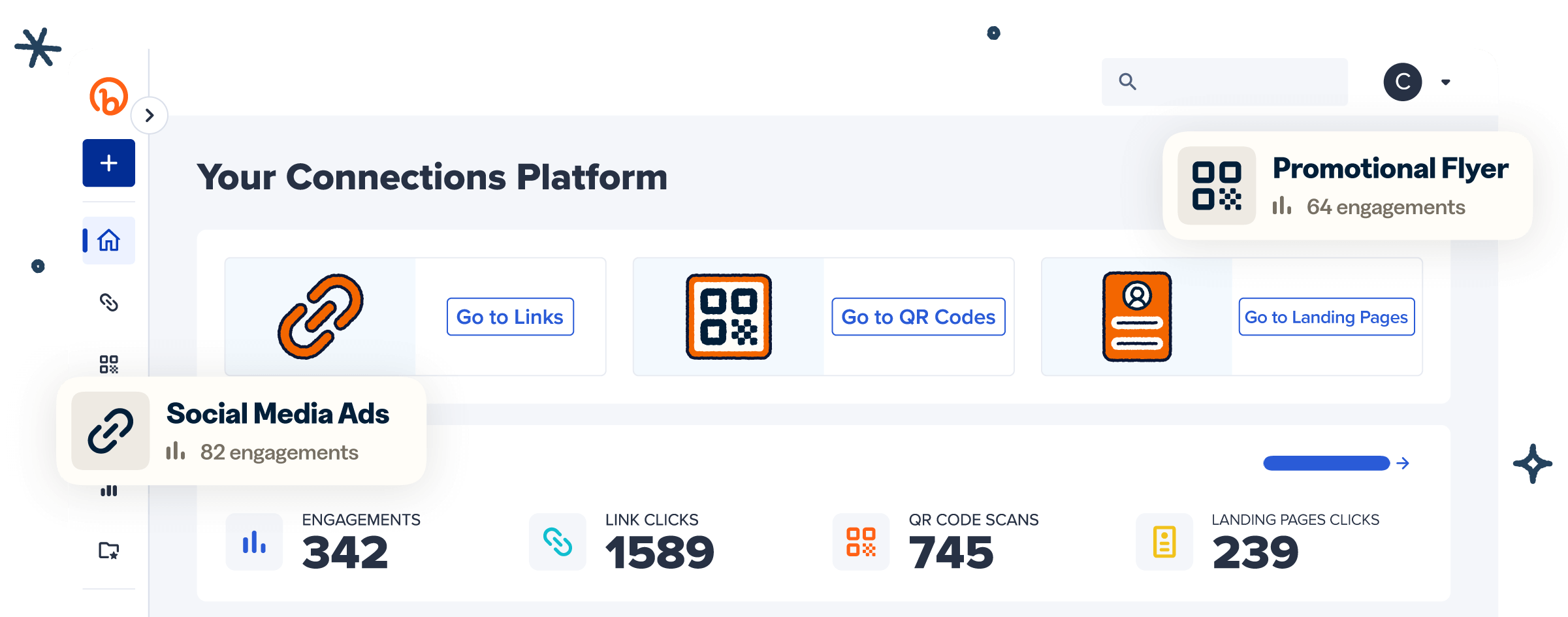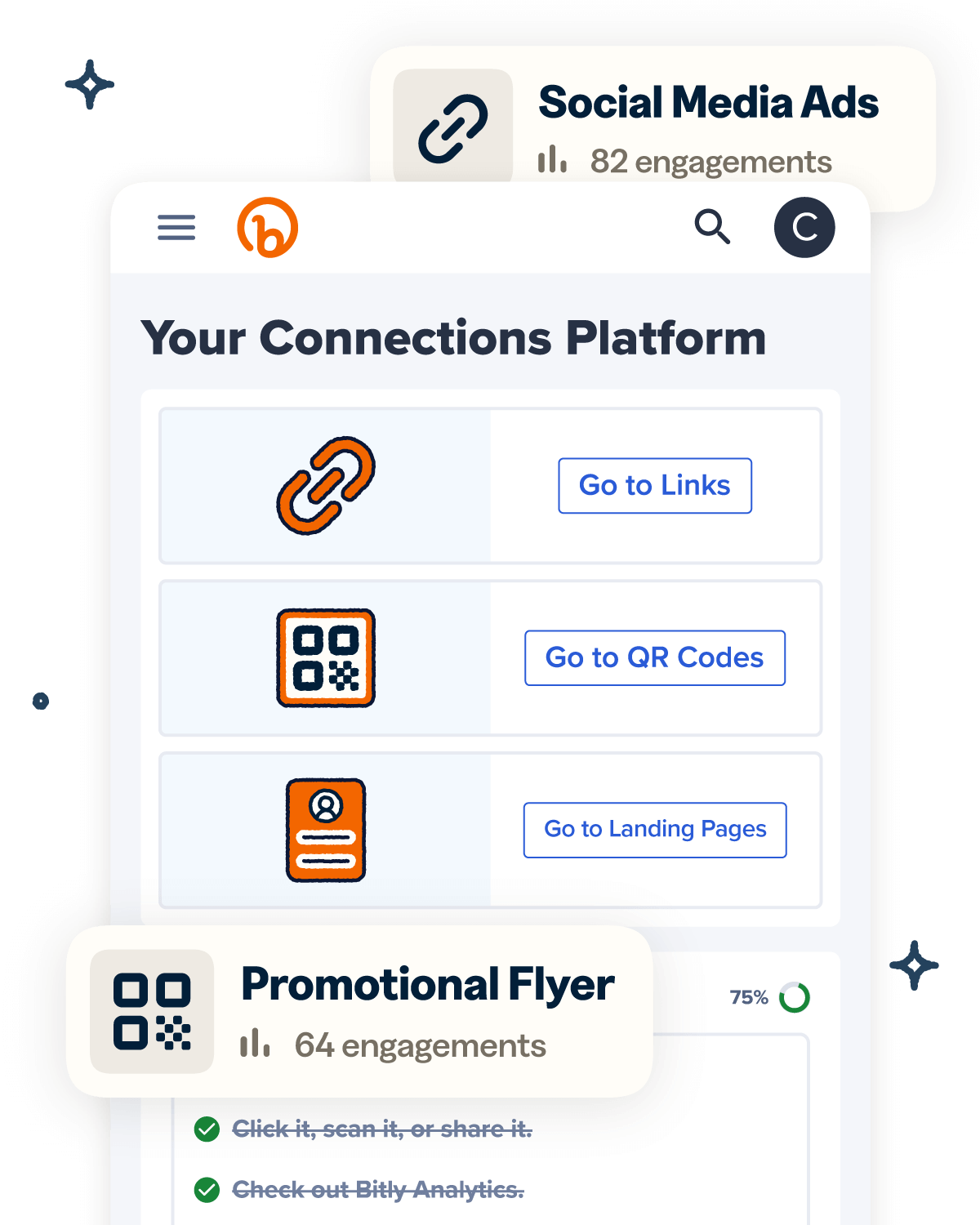Religious organizations face growing challenges when it comes to engaging their communities, encouraging donations, and sharing important information in an increasingly digital world. Traditional practices—like printed bulletins, passing the collection plate, and making weekly announcements—don’t always meet the needs of today’s mobile-first communities.
QR Codes for donations, event registration, and resource-sharing offer an easy, effective way to modernize faith-based initiatives.
From contactless giving to improved communication, QR Codes make it simple to engage your audience while staying true to your mission. They’re secure, customizable, and trackable, so you can better understand how your congregation interacts and adjust your outreach accordingly.
In this guide, we’ll explore how religious organizations are using QR Codes to connect, communicate, and create more meaningful interactions with their communities.
Note: The brands and examples discussed below were found during our online research for this article.
Why religious institutions are turning to QR Codes
With 91% of Americans owning a smartphone, mobile-friendly communication has quickly become a core part of daily life, affecting how people engage with their faith communities. From watching live-streamed sermons to signing up for volunteer work, more congregants now expect digital options.
Likewise, fewer people carry cash, and traditional methods like passing the offering plate aren’t as effective as they once were. Fortunately, online giving is on the rise and is projected to grow by 3.9% in 2025.
To keep pace, many religious institutions are turning to secure QR Codes for donations and outreach. These codes offer a simple, accessible way to connect with today’s digitally engaged audiences, meeting people where they already are without sacrificing the personal connections that make ministry meaningful.
How religious institutions use QR Codes
There are many creative ways faith-based nonprofits use QR Codes to blend traditional practices with modern tech. These small but powerful tools help streamline communication, increase participation, and support outreach.
Below are real-life examples and practical strategies that show how religious institutions are making the most of QR Codes.
Facilitating donations and tithing
As cash becomes less common, many religious institutions are finding that the traditional offering box or plate doesn’t bring in the same level of contributions. This shift has encouraged institutions to adopt more convenient, digital ways to give. QR Codes provide a quick, secure way to donate, no apps or complicated steps required.
Place QR Codes on benches, pews, or seating, or display them on-screen during livestreamed services, giving congregants instant access to digital giving platforms. In fact, churches that embrace online tithing have seen a 32% increase in donations, along with more frequent contributions.
Using Bitly’s Dynamic QR Codes, religious groups can also track scan volume, timing, and location (city/country) to refine their fundraising strategies and encourage recurring giving.
For example, you might notice higher scan rates at the beginning of the month that taper off towards the end. With that insight, you can ramp up your donation efforts at times when members are more likely to give. Over time, this data-driven approach turns a simple QR Code into a powerful tool for stewardship.
Whether your institution encourages tithing, zakat, temple donations, or general support, QR Codes offer a streamlined solution for any form of charitable giving.
Enhancing worship engagement and sermon access
Worshippers today often seek a more interactive experience, with easy access to sermon recordings, Quran references, or other worship materials. This is especially important for older members or those who cannot attend in person but still want to stay connected with their faith community.
QR Codes provide a simple solution by linking directly to livestreams, digital prayer books, and interactive sermon notes, making it easy for congregants to access resources from their smartphones. Even better, they can engage on their own schedule, revisiting sermons or catching up any time.
For organizations with multiple services or large congregations, QR Codes can also deliver personalized content. A code in the bulletin might link to that week’s sermon notes. At the same time, one on-screen during a service could direct people to follow along with scripture references, submit prayer requests, or access a digital version of the program.
Simplifying event registration and attendance tracking
Managing RSVPs, check-ins, and attendance for services, scripture study sessions, or community events can quickly turn into a logistical nightmare. Manual methods like paper forms and spreadsheets are time-consuming and prone to errors.
Evite QR Codes for your mosque, temple, church, or synagogue make the process easier for everyone. With a quick scan, attendees can register from their own devices, no paper forms or spreadsheets needed. You can also pair codes with a check-in app via URL to monitor attendance and capacity in real time, making events smoother, safer, and more organized.
Plus, QR Codes can link to event schedules, online forms, or speaker bios to help keep everyone informed. Over time, the data from these scans can help leaders spot attendance trends, plan more effectively, and allocate resources where they’re needed most.
Connecting congregants to important updates and resources
Most believers lead busy lives, making it easy for important updates or announcements to slip through the cracks. Printed newsletters and bulletin boards are often overlooked, and not everyone checks their email regularly. That’s where a more immediate solution can help.
When you incorporate QR Codes into your communication strategy, you can give your community instant access to digital bulletins, event calendars, and announcements. Post them on notice boards, include them in programs, or share them on social media platforms like Facebook or X (formerly Twitter).
For example, a QR Code could link directly to an event registration or information page, eliminating the need to type in long URLs or search through announcements. With just a scan, attendees get what they need, and the content stays current.
Religious organizations can also use QR Codes to distribute resources like prayer guides, khutbah or sermon notes, or religious classes. It’s a simple, effective way to keep everyone informed and engaged without the clutter of paper handouts.
Encouraging community engagement and volunteer sign-ups
Volunteers are the heart of many faith-based programs, but recruiting and organizing them isn’t always a walk in the park. It’s tough to manage sign-ups, track roles, and keep momentum going, especially with limited time and resources.
QR Codes simplify the process and invite more participation. Add one to your worship day program, bulletin, or social media posts that link directly to a dedicated landing page with a volunteer sign-up form.
You can also create targeted QR Codes for specific ministries, outreach programs, or charity drives that need volunteers. This will give members a clear call-to-action (CTA) and a meaningful way to contribute their time and talents where they’re needed most.
And with Bitly Analytics, you can track engagement in real time. See which codes are scanned most often, when, and where so you can adjust your outreach, allocate resources, and grow support for your most important initiatives.
How to set up a QR Code for faith-based donations and engagement
Getting started with QR Codes is simple, especially with a clear plan. This step-by-step guide will help you set up QR Codes that drive engagement and increase giving.
Choosing the right QR Code generator
A reliable QR Code generator is essential. Look for one that offers robust customization options, real-time analytics, and the ability to edit links after the code is created.
Bitly QR Codes are a strong option for faith-based organizations. You can update the destination URL anytime without reprinting or redesigning your materials. So, if a donation page changes or an event link expires, you can adjust the URL behind the scenes, saving time and resources.
Plus, with built-in analytics, you can track performance data like total scans per day and location (city and country level), helping you understand how audiences are engaging with your codes.
Customizing QR Codes for maximum impact
Religious institutions have a unique opportunity to make QR Codes feel more welcoming and familiar by adding recognizable branding elements like logos, colors, and faith-based symbols.
Including your organization’s logo or a meaningful icon can build trust and create a sense of connection. Using brand colors reinforces recognition and makes the code feel like part of your larger community identity.
Pairing QR Codes with clear, inviting CTAs takes it a step further. A donation code might say “Support our Mission” or “Make Your Donation Here.” A code for an event or community sign-up could read “RSVP for Sunday Brunch” or “Join Our Youth Group Today.” These quick phrases set expectations and make scanning feel personal and approachable.
You can also include a brief visual guide with scanning instructions, which is especially helpful for congregants who may be less familiar with the technology. A little clarity goes a long way in making the experience smooth for everyone.
Placing QR Codes for high engagement
Strategic placement makes all the difference in driving engagement. Ensure your QR Codes are easy to spot, scan, and act on by placing them in:
- Service programs: A natural home for QR Codes. Congregants already have them in hand during services, making accessing sermon notes, digital giving, or announcements easy.
- Signage around the building: Use notice boards, entryway posters, or lobby displays to share event details and community updates as people come and go.
- Websites and emails are perfect for connecting online visitors to the next steps, such as donation pages, registration forms, or live streams.
- Livestreams: Display a QR Code on-screen so remote worshippers can submit prayer requests, donate, or follow along with the service.
- Welcome pamphlets: Include a QR Code that leads to a new member registration form an easy next step for visitors wanting to stay connected.
Some faith communities are even using QR Codes on headstones and memorial plaques to honor loved ones. These codes can link to digital tributes, obituaries, or personal messages from family and friends. It’s a thoughtful way to blend tradition with technology, offering mourners a lasting way to connect and reflect.
Wherever you use your codes, the key is to ensure their placement is practical, purposeful, and accessible. Make sure all QR Codes are large enough to scan easily and positioned where people naturally look, like at the bottom of a program or the center of a screen. This helps ensure that every member, regardless of tech familiarity, can participate with ease.
Testing and tracking QR Code performance
Analyzing QR Code engagement is essential if you want to sharpen your outreach efforts and focus resources where they’ll have the greatest impact. Whether it’s a donation link in the bulletin or an event sign-up on a notice board, tracking performance helps you understand what’s working and what could use a tweak.
Bitly’s tracking features are a game-changer for this. Nonprofits use these analytics to gain insights into total scans, peak engagement times, and where traffic comes from via referrer data. If your institution has multiple locations or ministries, location insights (by city or country) can also help reveal which QR Codes are driving the most interactions. Either way, this data helps you fine-tune your strategy for even stronger results.
You can also create unique Bitly Codes for different campaigns or events to test variables like placement, design, or CTAs. These performance metrics are helpful when reporting back to leadership or assessing the impact of your outreach efforts.
Best practices for using QR Codes in religious institutions
QR Codes can transform how religious organizations connect with their communities, but success depends on accessibility, security, and thoughtful execution. Here are some pro tips to help make your implementation effective and inclusive.
Make QR Codes accessible for all congregants
Not everyone is tech-savvy, so accessibility is a must. QR Codes should be large enough to scan easily, especially for those with limited vision or unsteady hands. They should also be placed where congregants can comfortably reach them, like on seating cards or at eye level on notice boards.
If a code is too small or tucked away, people may miss or struggle to use it. Test different sizes and placements to see what works best for your community.
Older members or anyone new to QR Code technology may also need extra support. Offer alternative access options, such as a phone number or your website, and consider introducing QR Codes in a fun, low-pressure setting like an ice cream social with hands-on demos or printed step-by-step guides. These efforts can go a long way in easing anxieties and demonstrating the value of using QR Codes.
Ensure QR Code security and trust
Dynamic QR Codes are a smart solution for keeping links current and secure. Unlike Static QR Codes, which can’t be changed after they’re created, Dynamic QR Codes let you update the destination URL without replacing the code itself. This flexibility is especially useful if a donation webpage changes or an event link expires.
It also helps you avoid broken or outdated links, which can frustrate users and erode confidence. Keeping your QR Code destinations current reduces the chances of confusion, misinformation, or potential misuse, protecting your community and your organization.
Using trusted donation pages and payment processors is equally important. Congregants need to feel confident that their contributions and personal info are protected. Linking to reputable platforms with strong encryption adds an extra layer of assurance.
Finally, ensure every linked page uses a secure connection (HTTPS) and that the CTA clearly communicates what users should expect when scanning. Transparency builds confidence and encourages continued engagement with your organization’s digital offerings.
Don’t overload the congregation
When QR Codes are thoughtfully introduced, they can boost engagement and participation. However, adding too many at once can create the opposite effect, confusing your audience and reducing interaction.
When people are presented with multiple codes across bulletins, screens, and signage, they may not know which one to prioritize. As a result, they might end up skipping them altogether.
Instead, start small. Place a few QR Codes on key materials linking to things like donation forms or event sign-ups and then monitor their impact before adding more. This gradual approach helps your community ease into the technology without feeling overwhelmed and sets you up for stronger adoption over time.
Link to mobile-friendly content
You’ve made your QR Codes accessible, secure, and easy to scan—great work! Now, it’s time to ensure the content they lead to is user-friendly. Over 63% of all website traffic comes from mobile devices, making mobile optimization more important than ever.
When your landing pages are mobile-friendly, congregants can quickly access and interact with the content—no zooming, pinching, or squinting required. Whether it’s a donation form, event registration, or sermon notes, a smooth mobile experience helps keep people engaged.
Don’t have a mobile-ready website? Bitly Pages makes it easy to build one. These no-code landing pages come with templates designed for fast setup perfect for linking QR Codes to announcements, event details, or giving opportunities.
Mobile-friendly content also shows your organization is keeping up with the times and putting user needs first. When members feel considered, they’re more likely to stay connected and contribute.
The growing role of QR Codes in faith-based organizations
Innovations in QR Code technology are opening new doors for faith-based organizations, offering more than just a way to share links. These advances are making engaging congregants in interactive, personalized, and meaningful ways easier.
- Interactive QR Codes invite users to go beyond the scan. They might lead to a poll, survey, or virtual facility tour, making engagement more dynamic and two-way.
- Mobile apps are also gaining traction in religious communities. Many organizations now offer apps with sermon notes, prayer requests, event registration, and more. QR Codes make it easy for congregants to jump to a specific feature or page within the app (via URL).
- AI-powered analytics are giving religious leaders deeper insight into engagement patterns. By analyzing scan data and behavioral trends, institutions can tailor their outreach and communication to better meet the needs of their communities.
By embracing these emerging tools, ministries can stay responsive to change, meeting people where they are with fresh, relevant approaches that resonate across generations.
Elevate your religious institution’s digital strategy
From increasing donations to simplifying event management, QR Codes offer faith-based organizations a simple yet powerful way to meet the needs of modern congregants. Used thoughtfully, they can deepen connections, encourage participation, and make outreach more accessible and impactful both in person and online.
With Bitly QR Codes, you can customize each code to reflect your ministry’s identity, update links without reprinting materials, and access real-time insights to understand what’s working.
Whether you lead a church, mosque, synagogue, temple, or spiritual center, Bitly Codes offer a simple, powerful way to keep your community connected and engaged.
Ready to share your mission more meaningfully? Explore Bitly plans and start building a stronger, more connected ministry one scan at a time.




